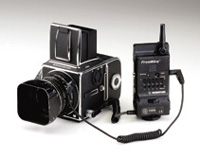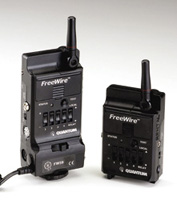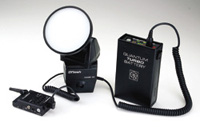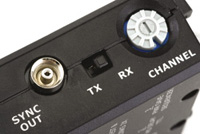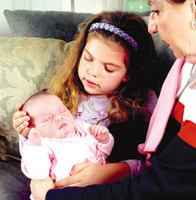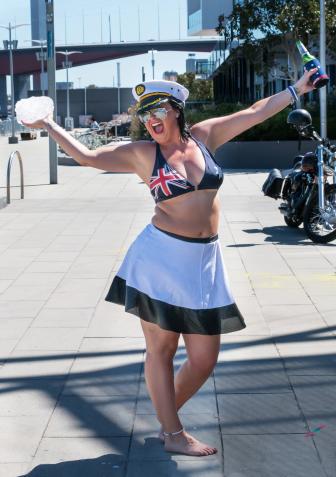The Quantum FreeWire
The Pro Wireless TTL System That Turns Heads
When Quantum, the well-known innovators and manufacturers of workhorse Turbo battery packs and robust Quantum Qflash portable strobe equipment, announced that they were introducing a wireless TTL flash transmitter, a lot of eyebrows were raised. "Wireless TTL with a Qflash?" asked a pro I know, "You mean you just use a transmitter on the camera and your off-camera flash is totally TTL? That's what they're claiming?" Why yes sir, that's exactly what they're claiming. Now mobile pros are not restricted only to their proprietary wireless TTL systems. Quantum is offering a complete dedicated TTL radio slave system. Radio Remotes |
|||
The idea of
taking a complicated thing like a wireless radio slave and combining a
complete camera-brand-specific TTL system seems like science fiction to
me. A dedicated unit that works with one camera, maybe, cause after all,
a lot of stuff has to take place in a 100,000th of a second. The shutter
has to open; the sync has to be sent to the transmitter; the transmitter
must send a signal; the receiver must pick up the signal; the receiver
must fire the flash; the camera must sense the flash output by reading
the amount of flash bouncing off of the film or CCD; it must then send
a "squelch" command to the transmitter to end; and then the
whole process has to be repeated until the flash ends its fire, and then
the shutter has to be closed. That's a lot of bang-bang stuff, and
the potential for mistake or failure seems tremendous. I've used
the Canon system with a single 550EX, but the prospect of an entire system
of Quantum Qflash heads all wirelessly synced and off-the-film Through
The Lens exposure control seemed too good to be true.
Ever the skeptic, I tested
out a complete FreeWire system. Using a Hasselblad 503CW I assembled a
local/remote system that consisted of a Qflash T2 on-camera, and a remote
Qflash T2 using the FreeWire off-camera. While wedding pros have been
using the local/remote system for decades, there's always that hit
or miss feeling when shooting like this. You know what I'm talking
about--those instances when the remote flash fires and bleeds into the
auto-flash "eye" for the main flash. Instead of elegant two-light
images you get underexposed rim lighting. (If you've ever shot this
way you know what I'm talking about.) The further your remote light
gets, the worse the problem gets. In extreme instances the main flash
can be fooled very badly and emit almost no front lighting at all. |
|||
Pro Units Once I got the two Turbo packs
charging I began to explore the FreeWire units. Quantum only makes one
FreeWire--it may be set up to transmit or receive, and operate in one
of four individual zones. The zones are important for the kind of work
I do. When set up on a location like a factory I might want to bracket
a series of exposures with different heads firing and not firing. By switching
the zone switches on the transmitter, I can easily control whether the
on-camera and all four of the off-camera flashes fire, even if I'm
in full manual exposure mode. In addition, each unit has eight independent
channels to allow any series of transmitter/receiver combinations to work
together or not. It sounds confusing but it's really not. This kind
of infinite control really comes in handy whether you're trying
to tackle a complicated lighting problem on location or just set up a
bunch of T2 units to work in full idiot-proof mode. |
|||
As with most radio slaves, the FreeWire units can also double as remote camera triggers. Imagine having your Hasselblad set up behind the backboard of an NBA game, six T2 units up in the rafters, eight FreeWires all totaled, and total automatic wireless TTL coverage. Wow! In The Studio, Or The Field... To test the accuracy of the TTL mode I first fired the T2 plugged directly into the camera, but about 3 ft away from the lens. I tried this with a cable and with the FreeWire. Results? Identical. Next I tried the on-camera/remote setup I described earlier. To really see if the TTL exposure made a difference I tried it two ways--first I shot with the T2 units in auto mode, set for f/5.6. This is the typical method that an event or wedding photographer would use. After this test I set everything back to full TTL and fired away. |
|||
The results were interesting. First of all, the auto mode of the T2 units is very impressive. I've been using old shoe mount units for a long time and the accuracy of the T2's was a revelation. While straight on two-unit shooting was excellent in both auto and TTL modes, as one of the light sources begins to move farther and farther off-camera the difference becomes apparent. Once one of the heads gets at least 90° off-axis the TTL mode really shines. As the auto modes continue to expose each flash separately, resulting in some over and underexposure scenarios, the TTL mode kept everything looking great. Of course in TTL mode there is no way to designate one head as the "main" light source and change its exposure, but at least you're guaranteed of dead-on accuracy. Since I did not have a remote auto eye plug-in unit for either T2 I couldn't test the accuracy difference between the two modes when the heads were fired through Chimera softboxes, but I did try it out. For me, this is the deal maker. I took the on-camera flash and mounted a Chimera Mini softbox, then put the second flash head about 12 ft away and mounted it to a Chimera Small striplight. Shooting in a living room I was able to move about cordlessly, change lenses, change backs, and do everything I needed to do, and all the while my color negs showed almost exactly the same exposure from shot to shot. It's really a remarkable level of freedom--moving lights in and out, changing lenses and shooting angles and generating one perfect frame after another. Shooting with the FreeWire system was a barrel of fun. As a radio slave system it is certainly among the most sophisticated units around. The near infinite level of control and Quantum's deep and broad array of accessories makes it a formidable unit on its own. Add in the ability to operate in full TTL mode with one or several flash heads and with any number of TTL compatible camera systems and you've got a winner. If I had any criticism I would love to see the ability to control ratios--so that each head could contribute a certain percentage to the exposure; I'd also like to see the FreeWire sync with camera manufacturers' TTL units in addition to the T2. Whether you shoot CEOs or brides,
take a good look at a complete FreeWire system. Sure, we're talking
about a serious investment for the whole rig as I tested, but the freedom
of operation, the spot-on reliability, and perfect frame after frame exposure
makes it a wise choice. |
